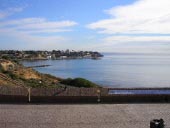
Cabo Roig Bay and Marina
One of the most popular holiday destinations along Spain’s southern Costa Blanca coastline, Cabo Roig is a beautiful and desirable resort. Renowned for its clean sandy beaches, its lovely marina and its excellent strip of bars, shops and restaurants, Cabo Roig offers everything you would want for a great family holiday. Though it is very busy during the summer months it is actually a superb location for a holiday any time of the year. Easy to reach from both Alicante and Murcia airports, Cabo Roig is handily placed for visiting other attractions along the Costa Blanca and Costa Calida.
The eye-catching 16th century watchtower, around which Cabo Roig originally grew, is now part of a restaurant complex which overlooks the recently modernised marina. An estimated 2 million euros was spent on the refurbishment of what is now one of the Costa Blanca’s most desirable mooring spots.
There are a number of excellent beaches to visit whilst on a trip to Cabo Roig. The main beaches are Cala Caleta and Cala Capitan both very popular with holidaymakers. Also within easy reach are the beaches at Campoamor, La Zenia and Playa Flamenca. All of these beaches are kept very clean and are usually raked every day, they are also safe for children.
Cabo Roig, along with the entire Costa Blanca region, has a wonderful climate and the sun shines on over three hundred days per year, the mean temperature being about 20 degrees C. You can usually expect to see little rainfall between May and October and the days are generally long and sunny. When rain does fall it is usually during the winter months, November and February being the most common months for rain. December and January are usually sunny and pleasant but with cold nights.
There is plenty to do in and around Cabo Roig, why not start with a trip into the nearby town of Torrevieja, with it’s wonderful promenade and marina and it’s many fine beaches? If you are visiting during the summer months, don’t forget the Aqua Splash park with its gigantic slides, refreshing pools and excellent picnic area. If you feel a little more adventurous you may wish to try out the go-karts at Punta Prima, here you can drive the full size karts or the kids can have a go on the mini karts or even the mini quads. In the summer the circus comes to town and this is a great attraction for the children and adults alike, being an old style circus, it has plenty of animals performing tricks to amaze and entertain. The younger at heart may prefer a trip to the busy resort of Benidorm, a journey of around an hour and a half (a coach picks up in Cabo Roig a couple of times a week), Benidorm has some wonderful facilities including Aqualandia, Terra Mitica and the Mundomar Marine Animal Park. Sporting enthusiasts may partake of the golfing, the water sports (the water sport resort of La Manga is only a 40 minute trip), or the fishing – there are angling safaris available for those preferring fresh water angling.
If you are looking to buy a property on the Costa Blanca, then Cabo Roig would be an ideal location, with plenty of variety ranging from 1 bedroom apartments to beautiful detached villas on the seafront.
Cabo Roig is easily reached by way of the N-332 coastal road (Cartagena to Alicante) or from the AP-7 motorway junctions 768 or 763. The closest airport is Murcia (San Javier) which is approximately 20 minutes drive away. Benidorm is located further north but can also be easily accessed from the N332.